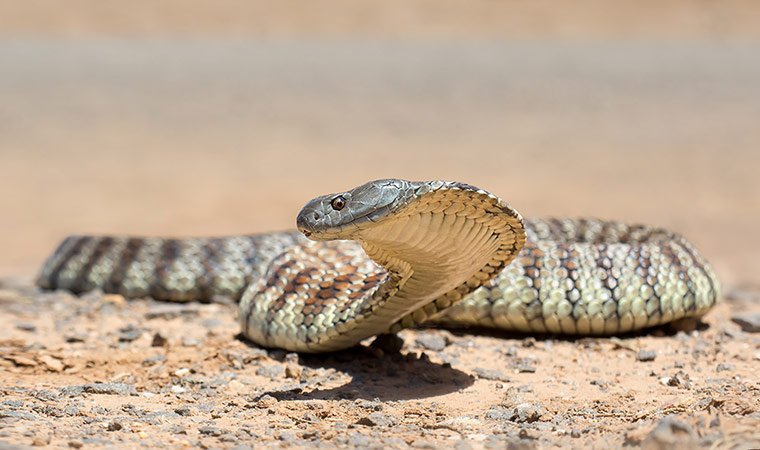
The venomous Tiger Snake is native to a number of Australian regions. It is well-known for its striking pigmentation and potent venom, so respect and caution are warranted. Tiger snakes inhabit a diversity of habitats, including wetlands, woodlands, and coastal areas. As essential components of their respective ecosystems, they aid in the management of rodent populations. However, deteriorating habitat, pollution, and human interactions threaten their survival.. Here are Tiger snake Guide on Food, Habitat, Size, Lifespan & Predators below-
Tiger Snake Stats in Table format
The stats are given below for Tiger snake
| Reptiles List | Tiger snake |
|---|---|
| Family | Elapidae |
| Type | Snake |
| Size | Medium |
| Length | Tiger snake: Up to 3-6 feet (0.9-1.8 meters) |
| Color | Tiger snake: The color varies depending on the species, but tiger snakes can have shades of brown, gray, or black with lighter or darker markings. |
| Weight | Tiger snake: Can weigh between 1 to 2 pounds.. |
| Lifespan | 10-20 years (or more) |
| Reproduction | Oviparous, lays eggs |
| Gestation Periods | The gestation period for a tiger snake is approximately 3 to 4 months. |
| Endangered Status | Least Concern (IUCN Red List) |
| Features | Distinct banding or stripes, venomous bite |
| Country & Areas | Australia, Tasmania |
Tiger Snake Natural Habitat and Distribution
Australian tigersnakes (Notechis spp.) are highly poisonous snakes. They can be found all over the coasts and a few islands off the coast of the southern and eastern parts of the continent. In addition to coastal heathlands and marshes, these snakes are also found in wetlands, grasslands, and woodlands. Their primary food source and a source of shelter, they are frequently spotted in close proximity to bodies of water like rivers, streams, and ponds.
Tiger Snake Physical Features and Adaptations
1. Body Structure
There is a distinct neck on a tiger snake, and its tail is short and thin. They can reach a maximum length of 2.5 meters in rare instances, while average lengths range from 1.2 to 1.8 meters. They are able to locate their prey thanks to their keen senses, particularly their eyesight and their capacity to detect chemical cues with a flick of their tongue.
2. Coloration and Patterns
The term “tiger snake” refers to the snake’s striking pattern of stripes and spots. On a background that goes from light yellow to olive or dark brown, there are alternating bands of yellow or cream and dark brown or black. Their camouflage is aided by their colour, which makes them blend in with the reeds and meadows they frequent.
3. Defense Mechanisms
Bites from tiger snakes can be deadly for humans because of the neurotoxic venom they produce. They have evolved to avoid conflict at all costs, thus their first instinct when disturbed is to run away. In the face of danger, however, they may become hostile and exhibit protective responses including hissing and flattening their bodies to appear larger. Their major line of defense against predators is a poisonous bite.

Tiger Snake Diet and Feeding Habits
Here are some information about Tiger Snake Diet and Feeding Habits
1. Diet Type
A tiger snake’s diet consists mainly of small mammals, birds, frogs, and even other snakes and lizards. What they eat depends on where they live and what kinds of animals are there.
2. Preferred Food Sources
In places with plenty of water, frogs and fish make up a large amount of a tiger snake’s diet. In arid areas, its diet shifts to include more rodents and birds.
3. Feeding Schedule
The tiger snake is primarily a slithering, ambush predator. They can see and smell prey far away, which helps them find food. When they find a meal, they pounce rapidly, injecting it with venom to render it helpless before swallowing it whole.
Tiger Snake Housing and Enclosure Requirements
Here are some information about Tiger Snake Housing and Enclosure Requirements
1. Terrarium Size and Setup
Those who want to keep tiger snakes as pets must offer a large, well-protected enclosure for them to live in. The length and width of the enclosure should be at least 1.5 times the snake’s length to ensure proper ventilation and movement. Tiger snakes are capable climbers, therefore a vertical climbing area is very helpful.
2. Substrate Options
The snake’s native habitat should serve as inspiration for the terrarium’s substrate. Cypress mulch, coconut husk, and aspen shavings are all acceptable substrates. These surfaces permit the snake to burrow if it so chooses and help keep humidity levels stable.
3. Temperature and Lighting
Tiger snakes are ectothermic, meaning they can not maintain their body temperature without additional heat. Having a heated basking zone at 28°C to 32°C (82°F to 90°F) and a colder region around 22°C to 26°C (72°F to 79°F) is essential for the health of your reptile. These temperatures can be attained by placing under-tank heating pads or ceramic heat emitters in the tank. For optimal health and vitamin D production, full-spectrum UVB lighting should also be provided.
4. Humidity and Water Needs
The humidity level in a tiger snake’s enclosure should be kept between 60% and 70%. To do this, a big water dish should be provided for the snake to bathe in or drink from as needed, as well as regular misting of the enclosure.
Tiger Snake Behaviour and Temperament
Here are some information about Tiger Snake Behaviour and Temperament
1. Activity Levels
Diurnal animals, like tiger snakes, are those that are most active during daylight hours. However, environmental conditions including temperature may affect their activity. They may enter a state of dormancy called brumation throughout the winter months.
2. Social Behaviour
The only times a tiger snake interacts with another tiger snake is during the wooing and mating process. Beyond these activities, they do not exhibit any other social behaviors of note.
3. Handling and Taming
Venomous snakes, such as tiger snakes, should only be handled by certified herpetologists or experts. If handled improperly, these snakes represent a major threat to human health due to their venom. If you keep a snake as a pet, you should avoid handling it as much as possible and instead focus on giving it the care it needs.
Tiger Snake Breeding and Reproduction
Here are some information about Tiger Snake Breeding and Reproduction
1. Mating and Courtship Rituals
The spring and early summer are prime breeding seasons for tiger snakes. Male tiger snakes will go out of their way to find fertile females during this time. Intricate gestures and actions are performed by males during courtship in an attempt to win the favor of the female. Once mating has been accomplished through wooing, internal fertilization takes place.
2. Incubation and Hatchlings
After mating successfully, the female tiger snake would place her eggs somewhere safe like a burrow or rotting foliage. Clutches can have anything from 10 to 40 eggs depending on the species. The female then abandons the nest, leaving the eggs to incubate on their own. Approximately 60–70 days after the eggs are laid, the hatchlings will emerge. The baby snakes are completely self-sufficient right from the start.
Tiger Snake Common Health Issues and Veterinary Care
Here are some information about Tiger Snake Common Health Issues and Veterinary Care
1. Respiratory Infections
Tiger snakes, like many other reptiles, are vulnerable to respiratory illnesses if maintained in unsuitable settings. These problems may be exacerbated by the combination of high humidity and low temperatures. Checkups with the vet on a regular basis will allow for early detection and treatment of any breathing issues.
2. Parasites:
Tiger snakes in captivity are susceptible to internal and external parasites including worms and mites. Routine veterinary checkups and fecal testing can help identify and treat parasite infestations.
3. Metabolic Bone Disease
Captive tiger snakes are susceptible to metabolic bone disease if they are not given enough vitamin D3 and UVB light. Weakened bones, abnormalities, and other health issues are the result of this disorder. Metabolic bone disease can be avoided with the right kind of nutrition and exposure to UVB sunshine.

Importance of Regular Vet Check-ups
Tiger snakes in captivity require routine veterinarian care to ensure their health and well-being. Regular checkups increase the likelihood that any health problems will be identified and treated successfully. In addition, vets can offer advice on how to best care for your snake in captivity, including husbandry, feeding, and enrichment.
Conclusion
The tiger snake’s out-of-the-ordinary look, unique adaptations, and complex behavior make it a noteworthy creature. These venomous snakes can be found all over Australia and play a crucial role as top predators and population controllers in the ecosystems they inhabit. The well-being of caged animals depends heavily on their living conditions, diet, and surrounding environment.
It is important to remember, however, that caring for potentially deadly snakes like tiger snakes in captivity requires expertise and diligence. Before selecting to keep a tiger snake or any other reptile as a pet, it is important to do thorough research, comply to regulatory rules, and consult with expert herpetologists or veterinarians to ensure the wellbeing of the animal and the safety of the keeper.
FAQs
Q: What is the family and Type of Tiger Snake?
The Tiger Snake, or Notechis scutatus, is a member of the Elapidae family, which also contains the cobra and the mamba. Tiger Snakes are highly venomous elapid snakes that are endemic to some regions of Australia and belong to the family Elapidae.
Q: What is the average size of a Tiger Snake ?
Tiger snakes typically grow to be between 4 and 5 feet long (1.2 to 1.5 meters). While most people top out at a height of 2 meters (about 6.5 feet), there are exceptions.
Q: How long can a Tiger Snake grow in size and length?
Tiger snakes, as was said earlier, can attain a maximum length of about 6.5 feet. Most individuals, however, are considerably smaller, measuring in at only about 1.2 to 1.5 meters (about 4 to 5 feet) in length.
Q: What colors do Tiger snakes come in?
Different subspecies and geographic locations can result in a wide range of coloration and patterning in tiger snakes. Backgrounds of olive, brown, or gray are common, and they often have contrasting yellow, orange, or cream stripes or bands across their bodies. The likeness of these patterns to tiger stripes is what gives the Tiger Snake its name.
Q: How big can a Tiger Snake get in weight?
Tiger snakes can range in weight from about 500 grams to 1 kilogram (1.1 to 2.2 lb), but the average is closer to the lower end of that range.
Q: How long do Tiger Snake s live?
The average life expectancy of a wild Tiger Snake is between 10 and 15 years.
Q: How do Tiger Snakes give birth?
Answer: A female tiger snake is ovoviviparous, meaning she carries her eggs until they are ready to hatch. Instead of laying eggs, the mother bears live offspring that have developed inside her oviducts.
Q: How long is the gestation period for a Tiger Snake?
Tiger snake females carry their young for about three to four months, during which time the embryos grow.
Q: Is the Tiger Snake endangered?
A: The Tiger Snake is not considered endangered as of my most recent check in September of 2021. Species’ conservation status may change over time for a number of reasons; therefore, it is important to double-check the most recent data from reliable sources.
Q: What are the prey of Tiger Snake s?
A: Tiger Snakes are carnivores that devour a wide variety of prey, including rodents, birds, amphibians, and other snakes. They might eat fish or even other snakes.
Q: Do Tiger Snakes have any Predators?
Even while venomous Tiger Snakes have fewer natural predators than nonvenomous snakes, larger birds of prey and other mammals may nevertheless pose a threat to adult Tiger Snakes. However, being venomous snakes affords them some degree of safety from predators.
Q: How Fast Does Tiger Snake Move?
The speed at which a Tiger Snake moves might change based on its surroundings. Although they can strike quickly when provoked, snakes generally move slowly and rely on stealth and ambush to kill their prey.
Q. What is the Bite Force of Tiger Snake in PSI?
The PSI (pounds per square inch) value of a Tiger Snake’s bite force is unknown to me. Species, size, and health of an individual snake all play a role in the severity of its bite. However, tiger snakes are venomous and can cause serious harm to humans and other animals if they bite.
Q. Can we keep Tiger Snake as pets?
As a general rule, the answer is no. Tiger snakes make terrible pets. They are quite dangerous for unskilled keepers because of their poison. Keeping them as pets is likely prohibited in many areas due to the risk they present.
Q. Are Tiger Snakes good for pest control?
The populations of small mammals and other prey species are kept in check, in part, thanks to tiger snakes. Because of their carnivorous nature, they play an important role in maintaining healthy rodent populations.
Q. Do Tiger Snake s require a UVB light source?
Like many other reptiles, Tiger Snakes benefit from time spent in the sun or other sources of UVB light. Vitamin D3, necessary for the absorption of calcium and general health, can be synthesized with the help of UVB light. Having a source of UVB light in their enclosure can improve their health while they are in captivity.
I hope you like reading on Tiger Snake FAQ Guide on Food, Habitat, Size, Lifespan and Predators.
